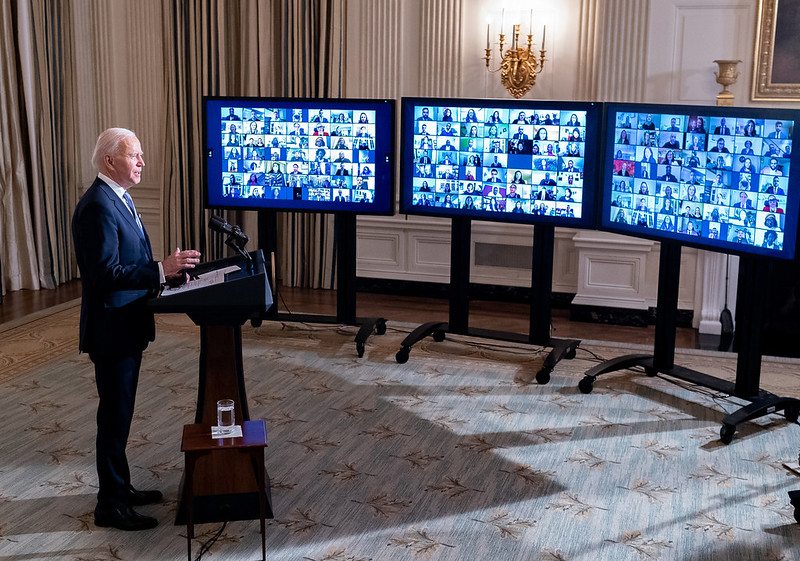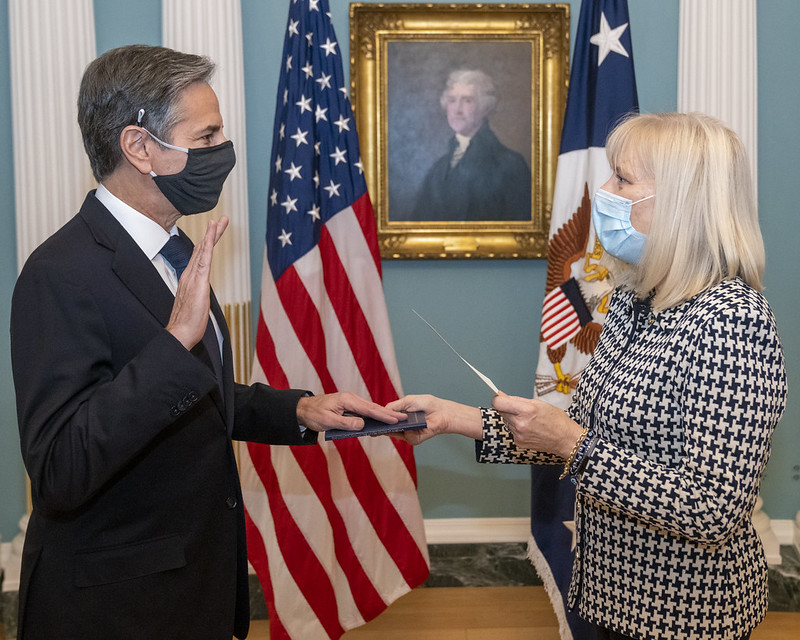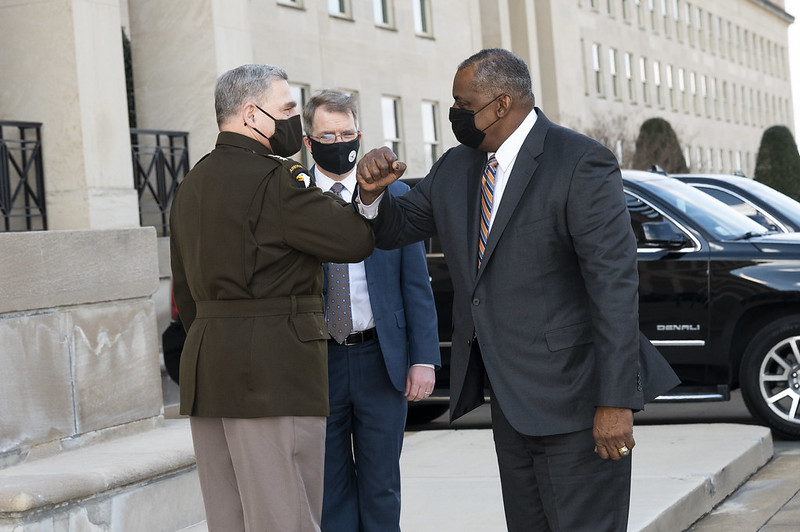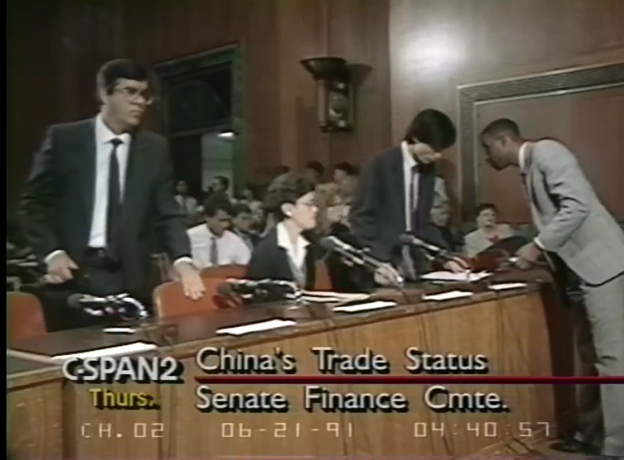EVENTS
Biden’s Cabinet Picks Target China

On January 20, President Joe Biden was sworn in, and he immediately launched a slate of executive actions to reverse cornerstone positions of the Trump administration, including rejoining the World Health Organization and Paris Climate Accord and reversing the “Muslim travel ban.” The Department of State signaled its intention to rejoin the United Nations Human Rights Council and the administration banned the use of “China Virus” to describe Covid-19, not to appease China but to show sensitivity to Chinese Americans. One can infer that Biden’s swift actions were meant to send a message: new leadership had arrived in town, with diametric policies to the previous administration.
One notable exception in this flurry of new actions was any change in policy towards China as established by Trump. In January’s Digest, we recapped Trump’s tumultuous relationship with China. There is little doubt that Biden will shun Trump’s uniquely acerbic tone. But the confirmation hearings of Biden’s cabinet picks took on a surreal—if not unpredictable—quality, as the opposition parties found common and comfortable ground on the topic of China.
Secretary of State
Biden nominated Antony Blinken, a long-time government advisor under the Clinton, Bush, and Obama administrations, for the nation’s top foreign policy position. At his Senate confirmation hearing on January 19, Blinken stated his belief that Trump had been correct to take a tougher stance towards China; he also stated that China was committing genocide in Xinjiang and expressed a desire to raise Taiwan’s international profile.

In an interview with MSNBC’s Andrea Mitchell, Blinken provided a more qualified position: “There’s no doubt that China poses the most significant challenge to us of any other country, but it’s a complicated one,” he said. “There are adversarial aspects to the relationship, there’s certainly competitive ones, and there’s still some cooperative ones, too.” He went on to defuse a question on US military intervention in China, emphasizing that the US needed to repair international alliances and “self-inflicted weaknesses,” a nod towards the impact of Trump’s China tariffs on American producers and consumers.
Blinken’s recent lunar new year call with Chinese foreign affairs director Yang Jiechi was far from a rote greeting of warm wishes for the Year of the Ox. In the call, Blinken touched on PRC actions in Xinjiang, Tibet, Hong Kong, and Taiwan, making clear that the new administration would not shy away from invoking human rights in foreign policy discussions—or in routine diplomatic calls.
Secretary of the Treasury

Like Blinken, Biden’s Secretary of the Treasury is no stranger to high-level government service. Janet Yellen was previously the Federal Reserve chair, and her testimony at her confirmation hearing echoed the Trump administration’s stance on China and trade. She called out China for “abusive, unfair and illegal practices”; “giving illegal subsidies to corporations”; and “horrendous human rights abuses.” And in the same vein as Blinken, she continued Trump-era China critiques while citing a planned review of Trump policies to ensure that they’re being used appropriately.
Secretary of Defense
Lloyd Austin, a retired four-star army general, didn’t pull any punches during his nomination hearing for Secretary of Defense, further indicating a united front among Biden’s cabinet. His testimony included a telling slip of the tongue: “We’ll have to have capabilities that allow us to hold—to present a credible threat, a credible deterrent, excuse me, to China in the future.”

2020 saw Trump wielding many aspects of government power towards China, and Austin’s testimony alluded to this tactic and its likely continuation under Biden: “I fully recognize that while I have the military component of this problem set, it’s a whole-of-government approach because China looks to compete with us along a spectrum of activities,” he said.
US Ambassador to the UN
Linda Thomas-Greenfield, a nearly 40-year veteran of the US Foreign Service and expert in African affairs, was tapped as Biden’s ambassador to the United Nations. In her testimony before the Senate Foreign Relations Committee, Thomas-Greenfield towed the same line as other cabinet picks, singling out China as the United States’ primary foreign policy focus and stating, “We know that China is working across the UN system to drive an authoritarian agenda that stands in opposition to the values of the institution.”

Thomas-Greenfield also offered an ardent apology for giving a speech at a Confucius Institute branch at Savannah State University, a historically black college, in 2019. The Confucius Institute, which aims to advance Chinese language and culture on college campuses around the world, has been criticized for its ties to the Chinese government and possible conflicts of interest within its administrative structure. Under Trump, the Confucius Institute was labelled a Foreign Mission, requiring employees to register with the US government and face similar restrictions to embassy employees.
Addressing China by Solving Problems “At Home”
Trump routinely deflected criticisms by looking outward for bad actors to blame, and China served as a useful catch-all in this respect. Unsurprisingly, negative views of China significantly increased under Trump. Initially, at least, Biden’s advisors haven’t strayed too far from Trump in their focus on China as the greatest threat to the US. But these views have been tempered by a subtle but consistent assertion that not all of America’s problems can be traced to foreign actors.

At a United States Institute for Peace event on January 29, appropriately titled “Passing the Baton,” Jake Sullivan, a Biden national security advisor, spoke cordially along with his Trump-era counterpart, Robert O’Brien. Sullivan spoke of US international dominance in terms of domestic renewal and a need for the US to get its own house in order:
“You know, when I think about the really foundational question of what is the most important national security priority facing the United States? It occurs to me something that Joe Biden has really reinforced for us, which is that foreign policy is domestic policy and domestic policy is foreign policy.”
This sort of nuance does not typically translate in partisan nomination hearings or media coverage. Over the next few years, we stand by to see if this tempered approach does indeed translate to policy and international diplomacy, or if it is merely drowned out by heated calls to address the “China threat.”
EXCHANGES
Exchanges is a feature that explores Dui Hua’s International Symposium on Girls in Conflict with the Law as well as other expert exchanges and dialogues.
“The power of telling the story from their own experience”

Gangs in Hong Kong. Art as advocacy. Indigenous communities over-policed and under-protected. The International Symposium on Girls in Conflict with the Law has continued to address the dynamic facets of gender-based juvenile justice with webinars on January 28, February 2, and February 15.

“Girls in Conflict with the Law in Hong Kong and Guangzhou,” held on January 28, approached juvenile crime from multiple perspectives. Karen Joe Laidler, director of the University of Hong Kong’s Centre for Criminology, looked at trends in juvenile crime over a 30-year period. Eric Chui, of the City University of Hong Kong, shared his research about girl gang behavior in Hong Kong. Zhang Hongwei of Jinan University discussed juvenile sentencing and changes to China’s civil code. The event was moderated by Lindsay Ernst, a clinical legal education specialist at the University of Hong Kong.
The following event, “Girls in Justice: Photographer Richard Ross in Conversation,” highlighted the work of the celebrated artist and juvenile justice reform activist. Ross was joined by Kasie Lee, assistant district attorney for the San Francisco Juvenile Unit, and social worker Michelle De Young. Ross’ photos often depict youth in carceral facilities alongside testimonials explaining how they ended up incarcerated. “The power of the voice, the power of telling the story from their own experience. I try to have both audio [and] simple images. I want things to haunt you,” Ross explained of his work, later adding, “you have to bear witness and you have to show people in power, ‘this is what you’re doing.’” The event was moderated by Patricia Lee of the San Francisco Public Defender’s Office.
February 15 saw “Findings and Calls to Justice with a Focus on Indigenous Girls and Youth in Canada and Hawaii,” with Christa Big Canoe, the legal director of Aboriginal Legal Services, presenting on her work and the treatment of Indigenous girls in North American justice systems. She was joined by Meda Chesney-Lind of the University of Hawaii, who commented on parallel trends in the Pacific area. The importance of agency also came across in Big Canoe’s presentation:
“What has to happen is Indigenous-driven processes that look to the culture and the family to rehabilitate, to rejuvenate, to reground. That’s where we actually see success. That’s where we see a lowering of recidivism and crime. That’s where we see a coming together of communities. That’s where we actually see the big healing work done, when it’s Indigenous-driven on the terms of the Indigenous people.”
Two more webinars are currently scheduled for the Symposium. In “Sex Trafficking,” on February 23, panelists Judge Susan Breall, renowned New York Times columnist Nicholas Kristof, and lawyer/advocate Dr. Antonia Lavine discuss sexual exploitation. On March 2, the University of Glasgow’s Susan Batchelor and Michele Burman discuss their research and experience in the webinar “Working with Young Women and Girls.”

Go here to learn more about these webinars, the speakers, and the Symposium.
PUBLICATIONS ROUND UP
Featured: Human Rights Journal, February 11, 2021: Dangerous Border Crossings: The Case of Cho Young-joo

Cross-border evangelization involves unforeseeable risks. The risk is arguably grave in China, where foreign missionaries routinely face harassment and arbitrary detention. South Korean Christians and Chinese citizens of Korean descent (hereafter ethnic Koreans) are no strangers to arrests for assisting North Koreans who attempt the long journey to freedom and citizenship in the South.
A judgment unearthed by Dui Hua revealed that Korean Christians in China en route to their overseas missions in Southeast Asia face similar risks. In May 2014, South Korean national Cho Young-joo (KR: 조영주; CH: 曹永周) was sentenced to seven years in prison for organizing illegal border crossings to Myanmar from Yunnan.
Read more here.
See Also: Press Statement, February 11, 2021: UN Group Rules China Has Arbitrarily Detained American Citizen Kai Li
SAN FRANCISCO (February 11, 2021) – In a strongly worded opinion (PDF), the United Nations Working Group on Arbitrary Detention (WGAD) has determined that American citizen Kai Li has been denied his due process rights and arbitrarily detained in violation of international law. Given the gravity of the violations against Mr. Li, the WGAD has referred the case to the Working Group on Enforced and Involuntary Disappearance, the Special Rapporteur on Torture and Other Cruel, Inhuman, or Degrading Treatment and Punishment, and the Working Group on the Independence of Judges and Lawyers.
Read more here.
See Also: Prisoner Updates, January 28, 2021
In this newly expanded publication, Dui Hua summarizes some of the most pressing prisoner cases from the last quarter of 2020. This installment of Prisoner Updates looks at cases related to Hong Kong, detainees challenging official COVID-19 narratives, subversion, and the sale of illicit religious materials.
Read more here.
JOHN KAMM REMEMBERS
John Kamm Remembers is a feature that explores Kamm’s human rights advocacy prior to and since Dui Hua’s establishment in 1999.
Shijing Juvenile Reformatory, June 1991

When I was president of the American Chamber of Commerce in 1990, I testified three times to the United States Congress as it was debating whether or not to renew China’s Most Favored Nation (MFN) tariff status. I presented what became known as the “Hong Kong argument”: Hong Kong, years away from being returned to China, would suffer disproportionately by removing China’s MFN. In one notable exchange between myself and Congressman Steve Solarz on May 16, 1990, I was asked whether I was advocating a “Hong Kong uber alles” policy. I reminded the congressman of the biblical story of Sodom and Gomorrah in which God spared the cities, both thoroughly evil, to spare the lives of a few good individuals.
In his decision to renew China’s MFN, President George H.W. Bush referenced the Hong Kong argument. This marked the first time in American history that the United States took into account Hong Kong’s interests when making a major foreign policy decision. My work received wide-spread acclaim in Hong Kong. A headline on the front page of USA Today referred to me as a “Hero in Hong Kong.”
Prior to my May 1990 testimonies I intervened on behalf of a young June 4 protester at a banquet hosted by senior Chinese official Zhou Nan in Hong Kong. After my testimony, the protester was released. I began to think I could use my vocal support for renewing China’s MFN to secure the release and better treatment of political prisoners. I decided to testify on two occasions in 1991.

For my 1991 testimonies, I prepared what came to be known as the Guangdong argument. I decided to explore whether or not there was a correlation between a province’s human rights record and its dependence on trade with the United States. Guangdong’s main export market was the United States, and most Americans of Chinese descent traced their roots to the province. The plan was to gather evidence and make a report to the Senate Finance Committee hearing on June 20.
Five Trips to Guangzhou
I made five trips to Guangzhou from February to June 1991. I met with former political and religious prisoners including Li Zhengtian (member of the Li Yizhe group and honorary advisor to the Guangzhou Student Federation, a leader of the June 4 protests), Father Tan Tiande, an underground Catholic church leader who spent decades in prison as a counterrevolutionary), and Pastor Samuel Lamb (a leader in the house church movement who, like Father Tan, had spent more than 20 years in prison for counterrevolution).
On these trips I also met with senior officials of the Guangdong and Guangzhou governments, including a vice-governor, a vice-chairman of the Foreign Economic and Trade Commission, a vice-chairman of the local branch of the China Council for the Promotion on International Trade (CCPIT), the bishop of the official Catholic Church who I pressed to end the harassment of Father Tan, and officials of the Guangdong Province Prison Bureau, and the Guangzhou Public Security Bureau.

Prior to my last trip to Guangzhou prior to my testimony, I flew to Beijing for a series of meetings with Chinese government officials. My host was a vice-chairman of the CCPIT. They arranged meetings with a vice president of the Supreme People’s Court during which I pressed for the release of the Li brothers (Li Lin and Li Zhi), Hong Kong Trade Representative Lo Haixing, and two individuals accused of helping dissidents leave China as a part of Operation Yellow Bird. (All were eventually released early).
I also met with the State Council to review moves in Washington to strip China of its trade privileges. Everyone I met with were afraid that China would lose MFN. They were motivated to assist me.
Prison Exports
A goal of the trip to Beijing was to get approval to visit a Chinese prison in Guangdong. In addition to getting information on how June 4 counterrevolutionaries and hooligans were being treated, I wanted to look into whether or not Chinese prisons were exporting products to the United States, a hot issue in Washington. Vice Chairman Xie of the CCPIT promised to assist. Not all Chinese prisons were open to foreigners. He said he’d ask the Guangzhou branch to identify a prison I could visit. They would meet me at Guangzhou Bai Yun Airport the next day.
I flew down to Guangzhou on Wednesday, June 12, and was met by the CCPIT officer who would accompany on the prison visit. The young man informed me that we would visit the Shijing Juvenile Reformatory the next morning.
After settling into my room, I was joined for lunch by a colleague from the Occidental Chemical Hong Kong office as well as the Guangzhou office manager. After lunch we visited Li Zhengtian’s art gallery in the Novotel Hotel.
At nine AM the next morning, my CCPIT handler met me and my Hong Kong colleague at the front door of the Garden Hotel. We drove for around 30 minutes to the Guangdong Provincial Juvenile Reformatory, commonly referred to as Shijing Juvenile Reformatory, in Baiyun District, where we were met at the entrance by the reformatory’s warden. Shijing was a facility open to foreigners, and quite a few had visited since the reformatory was founded in 1958. Senior leaders from Beijing had also visited, and we were shown a photograph of Qiao Shi, a member of the Politburo when he visited in 1985. We were ushered into the main office where we listened to a taped message in English. The warden then launched into a “brief introduction” to his “model reformatory.”

The Shijing Juvenile Reformatory was, and remains, the only juvenile reformatory in Guangdong Province. It houses all juveniles from age 14 (the current age of criminal responsibility) to 18 convicted by courts in Guangdong. It is administered by the provincial justice bureau. Juveniles who commit offenses that do not rise to the level of crimes are housed in work-study schools under the watchful eye of public security bureaus. The longest sentence in the juvenile reformatory was three years. In 1991 there were more than 1,700 male juveniles in Shijing, and 31 females. A contingent of 240 officers made up the staff.
Most of the juveniles in the reformatory had been convicted of theft and robbery, but there were some who had been convicted of more serious crimes like murder, rape, wounding, and arson. Juveniles were housed according to their crimes in 10 separate dormitories. Girls were housed in their own dormitory.
Hooligans
I asked the warden if any of the juveniles had been convicted of crimes of counterrevolution committed during the May-June 1989 protests. He replied no, but some inmates had been convicted of hooliganism. One youth had stolen RMB 400 from the warden’s office.
There was a recidivism rate of 10 percent for youth who passed through the reformatory, relatively high for China. In a typical year, 70 percent of inmates were rewarded points for good behavior and 17 percent received sentence reductions or parole. If inmates misbehaved, there were five levels of punishment. They would first undertake self-criticism. The next step was a warning, after which the juvenile would be written up. Especially serious offenders were shackled and finally, their sentences could be extended. The purpose of incarceration was to reform the juveniles so that they would become “useful citizens.” Strict but fair management was practiced, the warden assured us.
Each juvenile was given 40 catties of rice a month, RMB 50 worth of other foodstuffs, and RMB 3 spending money. The whole reformatory consumed 20,000 catties of fish every month. (One cattie is equivalent to 600 grams). Inmates were allowed to watch three hours of television a week, and two movies a month. They were permitted monthly visits by family members.

We then toured the facility, a large area of several hectares surrounded by brick walls topped with wire. It was a barren, hardscrabble place. Vegetation was sparse, common to this part of Guangzhou. The workshops and dormitories were connected by concrete paths. It had rained recently, and mud was everywhere. Potted plants lined the walkways.
After visiting the girls’ dormitory, we toured a workshop where boys were assembling radios for the Guangzhou Number Two Radio Factory. The juveniles were seated on benches. Each had a name plate with the length of their sentence. They did not make eye contact with the visitors. I was told that there were also workshops making garments and spare parts for adult prisoner factories managed by the prison bureau.
The warden denied that any products were manufactured for export. “The quality is too low, too simple,” he explained.
After our visit, we were driven back to the city where we were hosted to lunch by a CCPIT vice chairman. I returned to Hong Kong on the late afternoon train and ate dinner on board for RMB45.
Progress but Setbacks
There were large influxes of juvenile offenders into the reformatory in the early 2000s. The facility maxed out at 4,000 inmates, resulting in serious overcrowding. A new reformatory was constructed. Recent photos show bright, multistoried buildings with juveniles working on arts and crafts.
My visit to the Shijing Reformatory was my first visit to a Chinese carceral facility, and it touched off an interest in juvenile justice reform. I subsequently visited a juvenile reformatory in Beijing and a juvenile camp on one of Hong Kong’s offshore islands. In 2008, Dui Hua began a series of five juvenile justice exchanges with China’s Supreme People’s Court. We have contributed to meaningful reforms, but deep issues remain and are poised to worsen. Effective March 1, 2021, the age of criminal responsibility will drop from 14 to 12.
